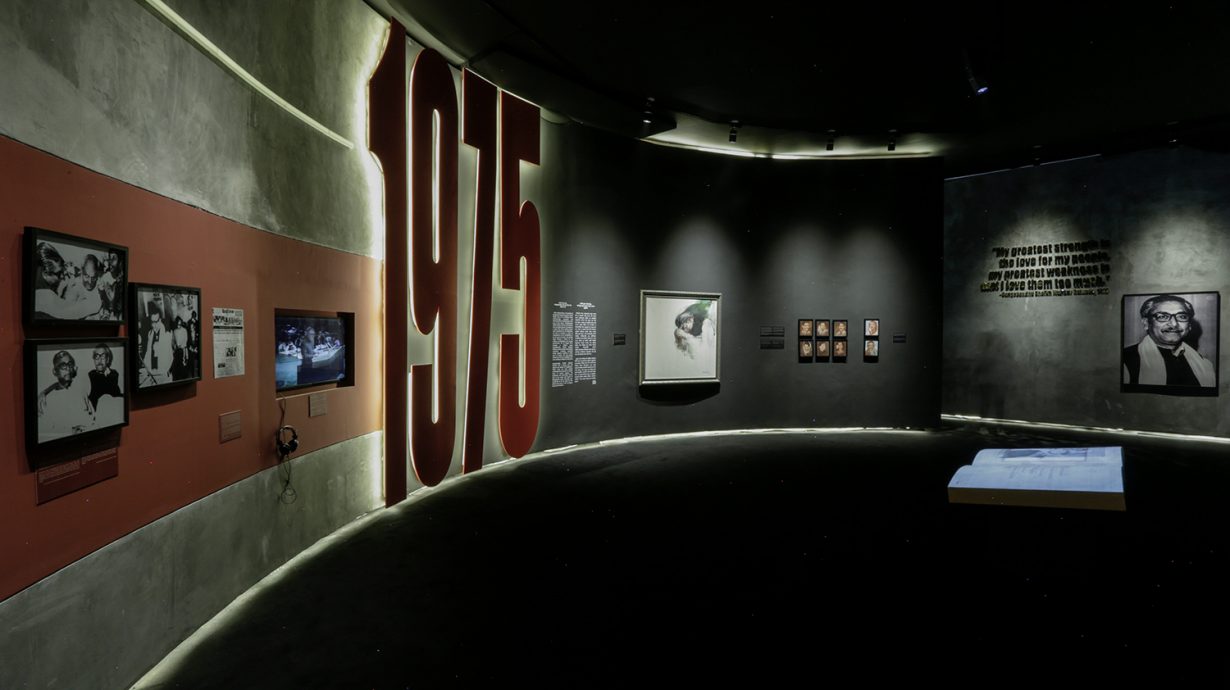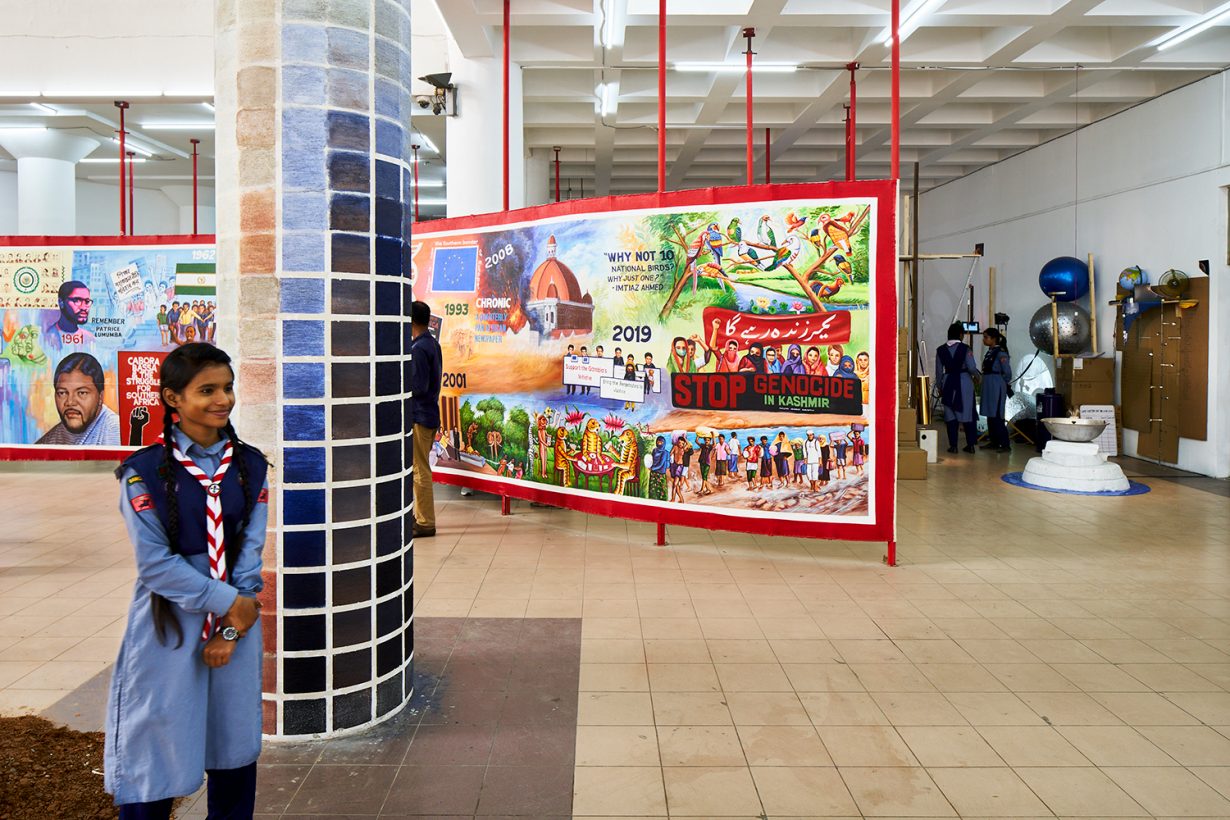It’s been a long time since the biennial Dhaka Art Summit took place in February this year. In more ways than one. The fact that it was titled Seismic Movements, a play on the notion of the summit as being something geological as much as social and political (or ‘how the world is moving and how we move in the world’, as the summit’s chief curator, Diana Campbell Betancourt, put it in her introduction in the catalogue – a theme that seemed to be summed up by Bharti Kher’s Intermediaries, 2020, two halves of two idols, supersized and stitched together to form one Frankensteinian new avatar, parked outside the Bangladesh Shilpakala Academy, which hosts the summit), seems oddly prescient now in ways that were presumably unintended at the time. That’s both the beauty and the curse of language: it’s a slippery and changing thing.
Part exhibition (divided into nine notionally discrete shows presenting both historical and contemporary work and knotting together themes such as feminism, colonialism, postcolonialism and, most dominant, of all the potential of grassroots and collective action – bottom up and horizontally structured), part conference, part moving-image festival (that section curated this year by The Otolith Group), part meeting point, the weeklong summit has established itself as one of the essential gathering points for people involved in contemporary art across Asia (and indeed beyond) to discuss, compare and contrast their practices and the contexts that shape them (with an emphasis, worth restating now, on in-person interaction). There’s naturally a certain dewy-eyed nostalgia that comes with reflecting on those last kinds of encounter – there was a growing awareness in February that COVID-19 might not be something that was totally confined to China (flights were being cancelled or postponed), but nothing, it seemed (a bit naively) then, to get overexcited about. But there’s also an opportunity to think about what makes such encounters important. And much of that lies in the chance encounters with works of art and people that you wander into without a plan – even if, when it comes to writing about it, referencing a well-ordered catalogue, you’re conditioned to make it seem like part of one. Perhaps it’s those elements of chance, or serendipity, that enliven everyday experiences, that we miss most while living with restrictions on our mobility.

I’d made a wrong turn on the way to meet a friend when I stumbled into a panel discussion that I later found out was titled ‘Collective Practice and Economy’ in an indoor-outdoor space on the Academy’s ground floor. The event was part of a series of discussions around collective working methods convened with input from Raw Material Company in Dakar, Senegal. This session was about how collective practices develop the conditions for independence and reform, something that seemed loosely to connect with a miniexhibition dedicated to Bangabandhu Sheikh Mujibur Rahman, the driving force behind Bangladesh’s independence and founder of the Shilpakala Academy, which took place in parallel to the summit itself (this year marks both the 100th anniversary of his birth and the 45th anniversary of his assassination). Someone about whom I had previously thought little and knew (shamefully, I began to feel) less. But one of the features of this edition of the summit was the way in which it folded together past and present time with a view to enabling future agency.
Back in the talk, presentations by a local, open-platform visual arts collective, Shoni Mongol Adda, and the Hong Kong Artist Union were followed by Bouba Touré, introducing a Mali-based agricultural collective called Somankidi Coura that he had cofounded in 1977. Somankidi Coura is a 25-hectare farming project (now evolved into a village of around 300 inhabitants), grounded in attempts to navigate issues of migrant returns, self-sufficiency, agency and workers’ rights. While the collective’s work involves the establishment and navigation of archives, discrete photography projects and more general documentation, the extent to which it can be described as a work of art, rather than a practical solution to immediate problems, is debatable. And it made the previous presentations feel all the more grounded for that, grounded that is in common-sense definitions of use and function and context, rather than a purely artistic sense of these. Other workshops, including a participatory event on how to form a collective (or, more properly, how to connect with and work with other people), led by Gudskul, now seemed less glib and superficial than they had at the time. They feel even less superficial now that such ways of working have become a more urgent necessity rather than a slowly building trend. The friend had to wait.

the artist; Mendes Wood DM, São Paulo, New York & Brussels; and Samdani Art Foundation, Dhaka
The experience of the summit is a bit like being in the midst of a whirlwind of ideas, with so many talks, workshops, exhibitions and film screenings going on simultaneously (collectively featuring around 500 participants), together with a local and international audience (made up of real people and art people) that numbers in the hundreds of thousands, that you grab onto things that fly by at the time, but some connections only become apparent once the dust has settled. The ‘Collective Practice and Economy’ discussion cast a new light on two archival exhibitions: Nobody Told Me There Would Be Days Like These (the title draws on the lyrics of a John Lennon song), which examined the work of groups operating in the fields of art, theatre and film in Bangladesh during the 1980s and how they had shifted their disciplines to deal with sociopolitical engagement; and Roots, which looked at the ways in which artists have been at the centre of art education during the 1950s and 60s. One of the most interesting developments of the summit over a decade of its existence is the way in which talks and exhibitions establish a kind of perpetual two-way feedback loop between the past and the present, one context and another, activated by the ability of each to use narrative and storytelling as a medium (which is perhaps where Touré’s presentation most obviously became a form of art). The ultimate effect of which is to emphasise that nothing comes from nothing and that current debates are more rooted in the past discussions than we might think.

Storytelling, past memories and new experiences also animated The Trans-Bangladesh, an eight-page (free) newspaper featuring prose, poetry and photography that was produced as part of a collaboration between the artist-led, Lagos-based Invisible Borders Trans-African Photographers Organisation, and local entities Drik Network, Pathshala Media Institute and the Chobi Mela photography festival. It looks at the relevance of history, the ways in which we explore other cultures or draw parallels from them to our own, and how generally we connect to the unfamiliar and the unknown: the kind of exchange that the summit is all about. Meanwhile, Geographies of the Imagination, a collaboration between Berlin-based Savvy Contemporary and Jothashilpa (a Dhaka-based collective of cinema-poster painters), took the form of a pair of banners snaking from past towards present (and being added to during the course of the summit), charting the nexus of geography and political power, collective resistance and transnational alliances, assessed from the vantage points of the 1905 partition of Bengal and the 1884 Congo Conference in Berlin, at which 14 colonial powers carved up Africa.
After passing by murals featuring national poets Rabindranath Tagore and Kazi Nazrul Islam in the Benapole land port in western Bangladesh, Lagos-based writer Kay Ugwuede notes in The Trans- Bangladesh that she is ‘intrigued by the country’s elevation of artists, the idea of such a thing as a “national poet”, and I wonder if this has carried on till present times or are vestiges of the past’. The summit advocates both a yes and a first step in articulating a why.
